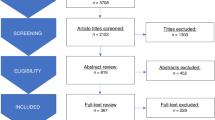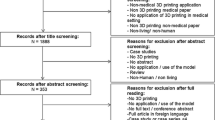Abstract
Purpose of Review
This article reviews the basics of 3D printing and provides an overview of current and future applications of this emerging technology in pediatric orthopedic surgery.
Recent Findings
Both preoperative and intraoperative utilization of 3D printing technology have enhanced clinical care. Potential benefits include more accurate surgical planning, shortening of a surgical learning curve, decrease in intraoperative blood loss, less operative time, and fluoroscopic time. Furthermore, patient-specific instrumentation can be used to improve the safety and accuracy of surgical care. Patient-physician communication can also benefit from 3D printing technology.
Summary
3D printing is rapidly advancing in the field of pediatric orthopedic surgery. It has the potential to increase the value of several pediatric orthopedic procedures by enhancing safety and accuracy while saving time. Future efforts in cost reduction strategies, making patient-specific implants including biologic substitutes and scaffolds, will further increase the relevance of 3D technology in the field of pediatric orthopedic surgery.







Similar content being viewed by others
References
Papers of particular interest, published recently, have been highlighted as: • Of importance •• Of major importance
Guo N, Leu MC. Additive manufacturing: technology, applications and research needs. Front Mech Eng. 2013;8:215–43.
Harrison N, Field JR, Quondamatteo F, et al. Preclinical trial of a novel surface architecture for improved primary fixation of cementless orthopedic implants. Clin Biomech. 2014;29(8):861–8.
Gibson LJ, Ashby MF. Cellular solids. Cambridge (UK): Cambridge University Press; 1997. https://doi.org/10.1017/CBO9781139878326.
Garcia-Cardosa M, Granados-Ortiz FJ, Ortega-Casanova J. Micromachines. 2021;13(1):73.
Lemu HG, Kurtovic S. 3D printing for rapid manufacturing: study of dimensional and geometrical accuracy. Advances in production management systems. Value networks: innovation, technologies, and management. Heidelberg: Springer Berlin Heidelberg; 2011. p. 470–479.
Cicconi P, Mandolini M, Favi C, Campi F, Germani M. Metal Additive manufacturing for the rapid prototyping of shaped parts: a case study. Comput Des Appl. 2021;18:1061–79.
• Jiang M, Chen G, Coles-Black J, Chuen J, Hardidge A. Three-dimensional printing in orthopaedic preoperative planning improves intraoperative metrics: a systematic review. ANZ J Surg. 2020;90(3):243–50. A well-researched systematic review reporting both objective and subjective benefits of 3D printing technology in the preoperative phase of care.
Kodama H. Automatic method for fabricating a three-dimensional plastic model with photo-hardening polymer. Rev Sci Instr. 1981;52(11):1770–3.
Crump SS. Fused deposition modeling (FDM): putting rapid back into prototyping; Proceedings of the 2nd International Conference on Rapid Prototyping; Dayton, OH, USA. 23–26 June 1991; pp. 354–357.
Kruth JP, Leu MC, Nakagawa T. Progress in additive manufacturing and rapid prototyping. Cirp Ann. 1998;47:525–40. https://doi.org/10.1016/S0007-8506(07)63240-5.
Seol YJ, Kang HW, Lee SJ, Atala A, Yoo JJ. Bioprinting technology and its applications. Eur J Cardiothorac Surg. 2014;46(3):342–8.
Yang L, Shang X-W, Fan J-N, et al. Application of 3D printing in the surgical planning of trimalleolar fracture and doctor-patient communication. Biomed Res Int. 2016;2016:2482086.
Alemayehu DG, Zhang Z, Tahir E, Gateau D, Zhang D-F, Ma X. Preoperative planning using 3D printing technology in orthopedic surgery. Yang L, ed. Biomed Res Int. 2021;2021:7940242.
Xu W, Zhang X, Ke T, Cai H, Gao X. 3D printing–assisted preoperative plan of pedicle screw placement for middle-upper thoracic trauma: a cohort study. BMC Musculoskelet Disord. 2017;18(1):348. https://doi.org/10.1186/s12891-017-1703-1.
Wu Z-X, Huang L-Y, Sang H-X, et al. Accuracy and safety assessment of pedicle screw placement using the rapid prototyping technique in severe congenital scoliosis. J Spinal Disord Tech. 2011;24(7):444–50. https://doi.org/10.1097/BSD.0b013e318201be2a.
Chen P-C, Chang C-C, Chen H-T, et al. The accuracy of 3D printing assistance in the spinal deformity surgery. Imagama S, ed. Biomed Res Int. 2019;2019:7196528. https://doi.org/10.1155/2019/7196528.
• Zeng G, Schmaranzer F, Degonda C, et al. MRI-based 3D models of the hip joint enables radiation-free computer-assisted planning of periacetabular osteotomy for treatment of hip dysplasia using deep learning for automatic segmentation. Eur J Radiol Open. 2021;8:100303. https://doi.org/10.1016/j.ejro.2020.100303. This study demonstrates the effectiveness of automated MRI-based segmentation technology for 3D printing in pediatric pelvic surgeries, compared to CT-based manual technology. This shows promising potential for establishing a radiation-free protocol in achieving clinically accurate pelvic models.
Markhardt BK, Beilfuss MA, Hetzel SJ, Goodspeed DC, Spiker AM. 3D-printed models for periacetabular osteotomy surgical planning. J hip Preserv Surg. 2020;7(4):748–54. https://doi.org/10.1093/jhps/hnab024.
•• Hedelin H, Swinkels CS, Laine T, Mack K, Lagerstrand K. Using a 3D printed model as a preoperative tool for pelvic triple osteotomy in children: proof of concept and evaluation of geometric accuracy. JAAOS Glob Res Rev. 2019;3(3). A well-written study demonstrating the use of an effective assessment tool to determine the geometric accuracy and clinical applicability of 3D-printed pelvic models for use in pediatric orthopaedic surgery.
Gálvez JA, Gralewski K, McAndrew C, Rehman MA, Chang B, Levin LS. Assessment and planning for a pediatric bilateral hand transplant using 3-dimensional modeling: case report. J Hand Surg Am. 2016;41(3):341–3. https://doi.org/10.1016/j.jhsa.2015.12.010.
Wei Y-P, Lai Y-C, Chang W-N. Anatomic three-dimensional model-assisted surgical planning for treatment of pediatric hip dislocation due to osteomyelitis. J Int Med Res. 2020;48(2):300060519854288. https://doi.org/10.1177/0300060519854288.
• Takeyasu Y, Oka K, Miyake J, Kataoka T, Moritomo H, Murase T. Preoperative, computer simulation-based, three-dimensional corrective osteotomy for cubitus varus deformity with use of a custom-designed surgical device. J Bone Joint Surg Am. 2013;95(22):e173. https://doi.org/10.2106/JBJS.L.01622. This is a well-written study that directly assessed relevant functional outcomes following the use of custom-designed surgical devices in the treatment of cubitus varus deformity.
Murase T, Oka K, Moritomo H, Goto A, Yoshikawa H, Sugamoto K. Three-dimensional corrective osteotomy of malunited fractures of the upper extremity with use of a computer simulation system. J Bone Joint Surg Am. 2008;90(11):2375–89. https://doi.org/10.2106/JBJS.G.01299.
Baraza N, Chapman C, Zakani S, Mulpuri K. 3D - printed patient specific instrumentation in corrective osteotomy of the femur and pelvis: a review of the literature. 3D Print Med. 2020;6(1):34. https://doi.org/10.1186/s41205-020-00087-0.
• Raza M, Murphy D, Gelfer Y. The effect of three-dimensional (3D) printing on quantitative and qualitative outcomes in paediatric orthopaedic osteotomies: a systematic review. EFORT open Rev. 2021;6(2):130–8. https://doi.org/10.1302/2058-5241.6.200092. A global systematic review with aggregate data spanning a decade demonstrating both quantitative and qualitative benefit attributable to 3D printing technology in pediatric orthopaedics.
• Katsuura Y, Qureshi SA. Additive manufacturing for metal applications in orthopaedic surgery. J Am Acad Orthop Surg. 2020;28(8):e349–55. https://doi.org/10.5435/JAAOS-D-19-00420. A well-written overview explaining the technical aspect of 3D printing production for surgical applications in orthopaedics.
Author information
Authors and Affiliations
Corresponding author
Ethics declarations
Conflict of Interest
Wei Wu, Samir Sabharwal, Michael Bunker, and Sanjeev Sabharwal declare that they have no conflict of interest.
Human and Animal Rights and Informed Consent
This article does not contain any studies with human or animal subjects performed by any of the authors.
Additional information
Publisher's Note
Springer Nature remains neutral with regard to jurisdictional claims in published maps and institutional affiliations.
Rights and permissions
Springer Nature or its licensor (e.g. a society or other partner) holds exclusive rights to this article under a publishing agreement with the author(s) or other rightsholder(s); author self-archiving of the accepted manuscript version of this article is solely governed by the terms of such publishing agreement and applicable law.
About this article
Cite this article
Wu, W., Sabharwal, S., Bunker, M. et al. 3D Printing Technology in Pediatric Orthopedics: a Primer for the Clinician. Curr Rev Musculoskelet Med 16, 398–409 (2023). https://doi.org/10.1007/s12178-023-09847-x
Accepted:
Published:
Issue Date:
DOI: https://doi.org/10.1007/s12178-023-09847-x




